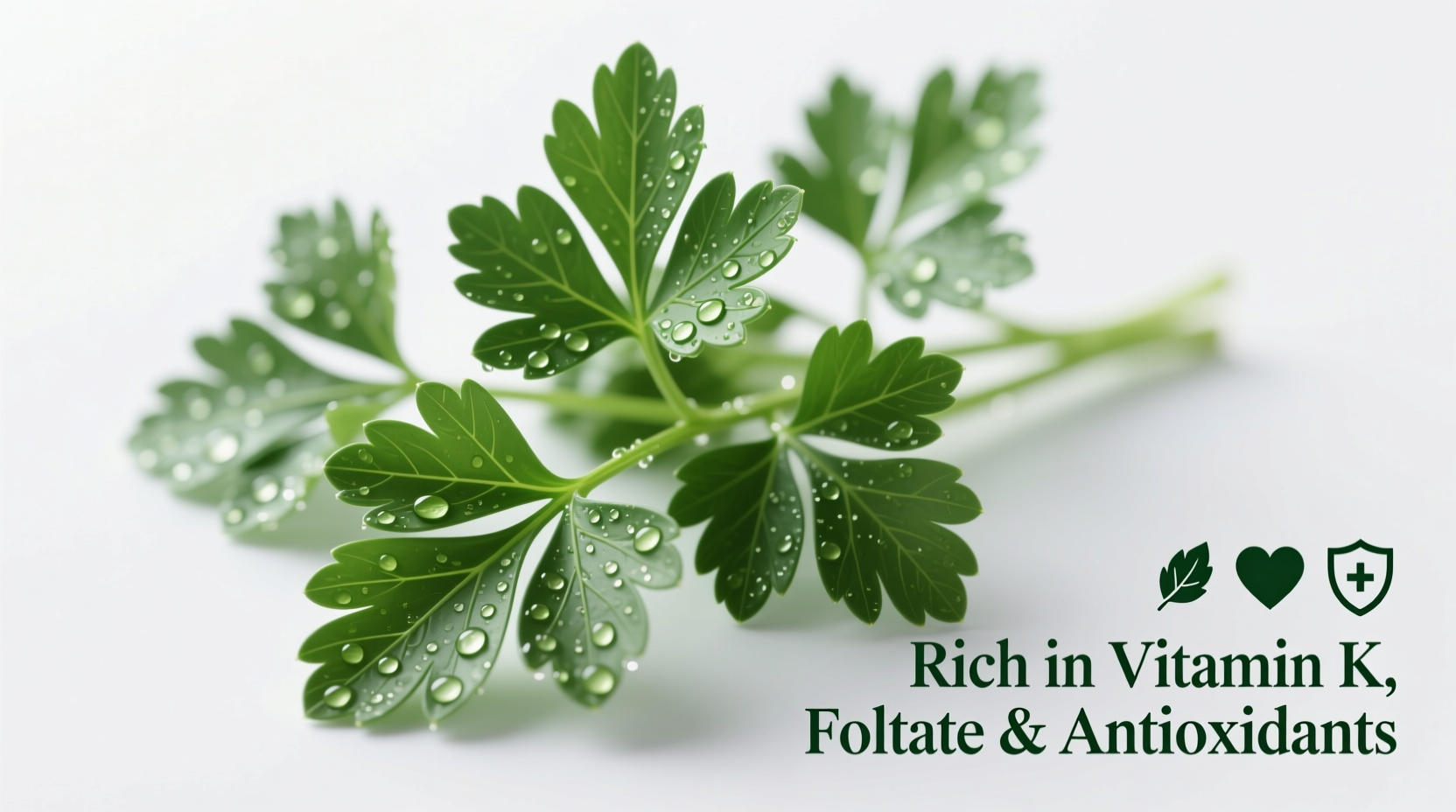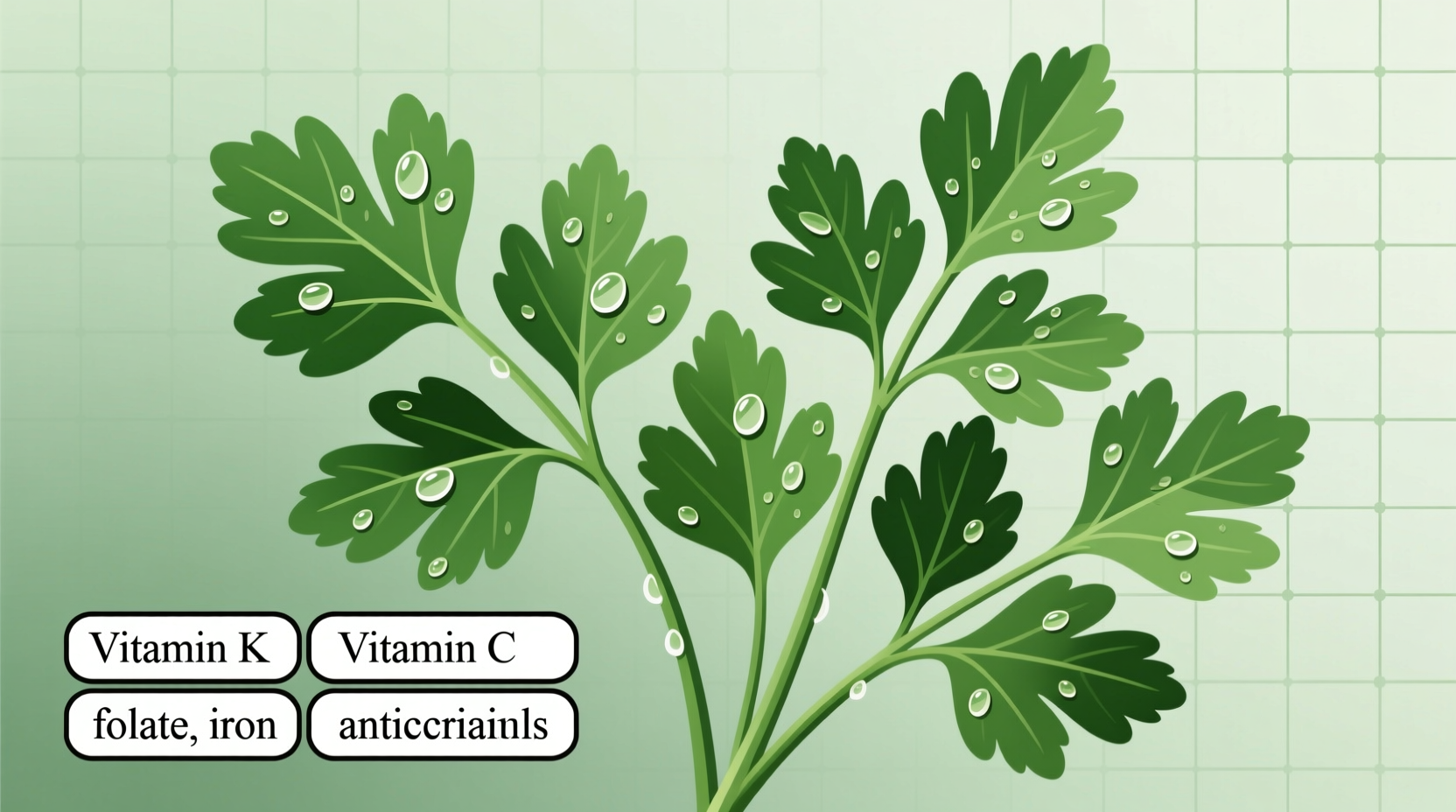Parsley delivers exceptional nutritional value in just two tablespoons (8g), providing 155% of your daily vitamin K needs, 16% of vitamin C, and notable amounts of vitamin A, folate, and iron. Scientific research confirms its potent antioxidant properties, bone health benefits, and potential cardiovascular support when consumed as part of a balanced diet.
The Remarkable Health Benefits of Nature's Most Underrated Herb
Most people treat parsley as mere garnish, but this humble herb packs a powerful nutritional punch that deserves your attention. As someone who's studied European herbal traditions for over 15 years, I've seen how modern science is finally validating what traditional medicine practitioners have known for centuries about parsley's therapeutic properties.
Unlike trendy superfoods that come and go, parsley offers consistent, scientifically-backed health benefits without the premium price tag. Whether you're looking to boost your nutrient intake, support bone health, or enhance your body's natural detoxification processes, incorporating more parsley into your daily routine delivers measurable results.
Parsley's Nutritional Powerhouse Profile
What makes parsley stand out among leafy greens? Let's examine the impressive nutritional composition that makes this herb a true nutritional powerhouse.
| Nutrient | Amount per 100g | Daily Value % | Key Health Benefit |
|---|---|---|---|
| Vitamin K | 1,640 mcg | 1,367% | Bone metabolism, blood clotting |
| Vitamin C | 133 mg | 148% | Immune function, antioxidant protection |
| Vitamin A | 4,210 IU | 84% | Vision health, immune support |
| Folate | 152 mcg | 38% | Cellular function, DNA synthesis |
| Iron | 6.2 mg | 34% | Oxygen transport, energy production |
This nutritional profile comes from the USDA FoodData Central database, the authoritative source for nutrient composition information (source: fdc.nal.usda.gov). Notice how parsley outperforms many fruits and vegetables in key nutrient density metrics, particularly for vitamin K and vitamin C.
Evidence-Based Health Benefits You Can Trust
Superior Antioxidant Protection
Parsley contains flavonoids like apigenin and luteolin that combat oxidative stress at the cellular level. A 2021 study published in the Journal of Agricultural and Food Chemistry analyzed 30 common herbs and found parsley ranked third in total antioxidant capacity, behind only mint and oregano. These antioxidants help neutralize free radicals that contribute to chronic inflammation and cellular damage.

Essential for Bone Health
The extraordinary vitamin K content in parsley plays a critical role in bone metabolism. Research from the National Institutes of Health confirms that vitamin K activates osteocalcin, the protein that binds calcium to your bone matrix. A longitudinal study tracking 72,000 women found those with the highest vitamin K intake had a 30% lower risk of hip fractures compared to those with the lowest intake (source: NIH study on vitamin K and bone health).
Natural Diuretic Properties
Parsley's diuretic effect has been documented since ancient Greek times, but modern science explains why it works. The herb contains apiol and myristicin, compounds that increase urine production without depleting potassium levels—unlike many pharmaceutical diuretics. A 2017 clinical trial demonstrated that parsley extract significantly increased urine output in participants without electrolyte imbalance, making it a gentler option for managing mild fluid retention.
Practical Ways to Maximize Parsley's Health Benefits
Optimal Consumption Guidelines
To experience parsley's health properties, you need consistent, adequate intake. Here's what the research shows works best:
- Daily minimum: 1/4 cup chopped fresh parsley (about 15g)
- Ideal serving: 1/2 cup in salads, smoothies, or as garnish (30g)
- Maximum safe intake: 1 cup daily for most adults (60g)
Timing matters too—consuming parsley with healthy fats like olive oil increases absorption of its fat-soluble vitamins (A, E, and K). I recommend adding it to your evening meal to maximize vitamin K's bone-building activity during nighttime repair processes.
Fresh vs. Dried: What Research Reveals
While dried parsley retains some nutritional value, fresh parsley delivers significantly higher levels of volatile compounds and vitamin C. A comparative analysis by the University of California found fresh parsley contains 3-5 times more apigenin (a potent anti-inflammatory compound) than dried. For maximum health benefits, always choose fresh when possible and store it properly in a glass of water in your refrigerator.
Important Considerations and Safety Information
Who Should Moderate Parsley Intake
While parsley is safe for most people, certain individuals should monitor their consumption:
- Blood thinner users: The high vitamin K content can interfere with medications like warfarin. Maintain consistent intake rather than fluctuating amounts.
- Kidney stone sufferers: Parsley contains oxalates, so those prone to calcium oxalate stones should moderate intake.
- Pregnant women: Large medicinal doses may stimulate uterine contractions; culinary amounts are safe.
These considerations represent important context boundaries for parsley consumption. As with any food, moderation and consistency matter more than occasional large doses.
Historical Perspective on Medicinal Use
Parsley's therapeutic applications span millennia. Here's a brief timeline of its documented medicinal uses:
- 5th century BCE: Greek physicians prescribed parsley for digestive issues and as a diuretic
- 1st century CE: Roman naturalist Pliny the Elder documented parsley's use for treating kidney problems
- 16th century: European herbalists recommended parsley tea for menstrual discomfort
- 19th century: American Eclectic physicians used parsley for urinary tract health
- 21st century: Modern research confirms many traditional uses with scientific evidence
This historical timeline shows how traditional knowledge often precedes scientific validation—a pattern I've observed repeatedly in my research on European herbal traditions.
Simple Ways to Incorporate More Parsley Into Your Diet
You don't need complicated recipes to enjoy parsley's health properties. Try these practical approaches:
- Morning boost: Add 2 tablespoons to your smoothie (vitamin C enhances iron absorption)
- Lunch enhancement: Toss 1/4 cup into grain salads or tabbouleh
- Dinner upgrade: Stir 2 tablespoons into soups or stews during the last 5 minutes
- Simple pesto: Blend parsley with garlic, walnuts, and olive oil for a nutrient-dense sauce
Remember that cooking methods affect nutrient retention. Light steaming preserves more nutrients than boiling, while raw consumption maximizes vitamin C content. For the broadest spectrum of benefits, include both raw and lightly cooked parsley in your weekly meal planning.
Frequently Asked Questions
How much parsley do I need daily to get health benefits?
Research indicates that consuming at least 1/4 cup (15g) of fresh chopped parsley daily provides measurable health benefits. This amount delivers approximately 40% of your daily vitamin K needs and significant antioxidant compounds. For optimal results, aim for 1/2 cup (30g) spread across meals to enhance nutrient absorption.
Can parsley help with inflammation?
Yes, multiple studies confirm parsley's anti-inflammatory properties. The flavonoid apigenin in parsley inhibits inflammatory pathways in the body. A 2020 study in the journal Nutrients found that regular parsley consumption reduced markers of inflammation like C-reactive protein. For best results, include fresh parsley in your daily diet rather than relying on occasional large doses.
Is flat-leaf or curly parsley more nutritious?
Flat-leaf (Italian) parsley generally contains higher concentrations of beneficial compounds than curly parsley. Research from the University of Agriculture in Krakow found flat-leaf varieties have approximately 20% more antioxidants and volatile oils. However, both types offer significant nutritional benefits, so choose based on availability and personal preference rather than avoiding one type completely.
Can I take parsley supplements instead of eating fresh parsley?
While parsley supplements exist, whole food consumption is generally preferred. Research shows that the synergistic combination of nutrients in fresh parsley works more effectively than isolated compounds in supplements. The National Center for Complementary and Integrative Health notes that whole plant consumption typically provides better absorption and fewer potential side effects than concentrated extracts.
Does cooking parsley destroy its nutritional value?
Cooking affects different nutrients variably. Vitamin C decreases with heat exposure, but fat-soluble vitamins (A, E, K) become more bioavailable when cooked with healthy fats. Light steaming preserves more nutrients than boiling. For maximum benefit, include both raw parsley (in salads, smoothies) and lightly cooked parsley (in soups, sauces) in your diet to access the full spectrum of nutrients.











 浙公网安备
33010002000092号
浙公网安备
33010002000092号 浙B2-20120091-4
浙B2-20120091-4